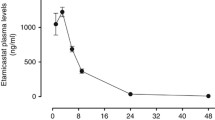Summary
It has been reported that naloxone, an opiate receptor antagonist, blunts the hypotensive effect of captopril in normotensives. However, our previous data did not show any interaction between captopril given acutely and naloxone (0.1 mg/kg) in hypertensives. To test whether a greater naloxone dose could interfere with the hemodynamic effect of chronically administered captopril, 12 male hypertensives were studied: Six of them had been under captopril treatment (50 mg tid) for at least 1 month, whereas the others had been drug free for the same time. Both groups randomly received a saline or naloxone (0.2 mg/kg) infusion for 1 hour, and blood pressure, heart rate, PRA, plasma aldosterone, adrenaline, and noradrenaline were measured at regular intervals before, during, and after naloxone infusion. In drug-free hypertensives, naloxone tended to reduce blood pressure slightly and did not modify heart rate, PRA, plasma aldosterone, adrenaline, or noradrenaline. In captopril-treated hypertensives, naloxone did not blunt the hypotensive effect of captopril, but rather enhanced it, without changing the heart rate, adrenaline, and noradrenaline. Moreover, naloxone increased the renin-stimulating action and did not modify the aldosterone-inhibiting effect of captopril. Our results show that the hemodynamic action of captopril given chronically is not influenced by opioid receptor blockade and therefore that the antihypertensive effect of this drug seems to be unrelated to the activation of the opioidergic system.
Similar content being viewed by others
References
Vidt DG, Bravo EL, Fouad FM. Captopril.N Engl J Med 1982; 306:214–219.
Hatton R, Clough D, Faulkner K, et al. Angiotensin converting enzyme inhibitor resets baroceptor reflexes in conscious dogs.Hypertension 1981; 3:676–681.
Campbell BC, Sturani A, Reid JL, Evidence of parasympathetic activity of the angiotensin converting enzyme inhibitor, captopril, in normotensive man.Clin Sci 1985; 68:49–56.
Sturani A, Chiarini C, Degli Esposti E, et al. Heart rate control in hypertensive patients treated by captopril.Br J Clin Pharmacol 1982; 14:849–855.
Ajayi AA, Camphell BC, Howie CA, et al. Acute and chronic effects of converting enzyme inhibitors enalapril and lisinopril on reflex control of heart rate in normotensive man.J Hypertens 1985; 3:47–53.
Cody RJ, Tarazi RC, Bravo EL. Haemodynamics of an orally-active converting enzyme inhibitor (SQ 14225) in hypertensive patients.Clin Sci Mol Med 1979; 55:453–459.
McQueen DS. Opioid peptide interactions with respiratory and circulatory system.Br Med Bull 1983; 39:77–82.
Rubin PC. Opioid peptides in blood pressure regulation in man.Clin Sci 1984; 66:625–630.
Arregiu A, Lee CM, Emson PC, et al. Separation of human brain angiotensin-converting enzyme from enkephalindegrading activity.Eur J Pharmacol 1970; 59:141–144.
Schwartz JC. Metabolism of enkephalins and the inactivating neuropeptidase concept.Trends Neuroscience 1983; 6:45–48.
Stine MS, Yang HY, Costa E. Inhibition of in situ metabolism of3H-Met5-enkephalin and potentiation of Met5-enkephalin analgesia by captopril.Brain Res 1979; 188:295–299.
Di Nicolantonio R, Hutchison JS, Takata Y. et al. Captopril potentiates the vasodepressor action of metenkephalin in anaesthetised rats.Br J Pharmac 1983; 80:405–408.
Sawynok J, Pinsky C, LaBella FS. Specificity of naloxone as an antagonist (mini review).Life Sci 1979; 25:1621–1632.
Montastruc P, Montastruc JL, Gillard-Plaza G. Influence of naloxone on the captopril-induced decrease in vagal pressor reflexes.J Pharmacol (Paris) 1984; 15:421–426.
Millar JA, Sturani A, Rubin PC, et al. Attenuation of the antihypertensive effect of captopril by the opioid receptors antagonist naloxone.Clin Exp Pharmacol Physiol 1983; 10:253–259.
Rubin PC, Millar JA, Sturani S, et al. The influence of naloxone on the circulatory effects of captopril.Br J Clin Pharmacol 1984; 17:713–717.
Ajayi AA, Campbell BC, Rubin PC, et al. Effect of naloxone on the actions of captopril.Clin Pharmacol Ther 1985; 38:560–565.
Bernini GP, Taddei S, Graziadei L, et al. Naloxone does not modify the antihypertensive effect of captopril in essential hypertensive patients.J Hypertens 1985; 3 (Suppl 2):117–119.
Geppetti P, Spillantini MG, Frilli S, et al. Acute oral captopril inhibits angiotensin converting enzyme activity in human cerebrospinal fluid.J Hypertens 1987; 5:151–154.
Evans JM, Hogg MIJ, Lunn JN, et al. Degree and duration of reversal by naloxone of effects of morphine in conscious subjects.Br Med J 1974; 2:589–591.
Ngai SH, Berkowitz BA, Yang JC, et al. Pharmacokinetics of naloxone in rats and man. Basis for its potency and short duration of action.Anesthesiology 1976; 44:398–401.
Rubin PC, McLean K, Reid JL. Endogenous opioids and baroreflex control in humans.Hypertension 1983; 5:535–538.
Rubin PC, Swezey S, Blaschke TF. Naloxone lowers plasma-prolactin in man.Lancet 1979; 1:1293.
Rubin PC, Blaschke TF, Guilleminault C. Effect of naloxone, a specific opioid inhibitor, on blood pressure fall during sleep.Circulation 1981; 63:117–121.
Rubin PC, McLean K, Reid JL. Endogenous opioids modulate central nervous system blood pressure control in man.Clin Sci 1982; 63:331–333.
Ajayi AA, Rubin PC, Reid JL. Captopril and opiate antagonism in essential hypertension.Br J Clin Pharmac 1986; 21:543–545.
Pitterman AB, Marks ES, Keiser HR. Failure of naloxone to modify the blood pressure action of captopril.Clin Res 1982; 30:339–341.
Author information
Authors and Affiliations
Rights and permissions
About this article
Cite this article
Bernini, G.P., Lucarini, A.R., Vivaldi, M.S. et al. Naloxone does not antagonize the antihypertensive effect of chronic captopril therapy in hypertensive patients. Cardiovasc Drug Ther 3, 829–833 (1989). https://doi.org/10.1007/BF01869567
Issue Date:
DOI: https://doi.org/10.1007/BF01869567




